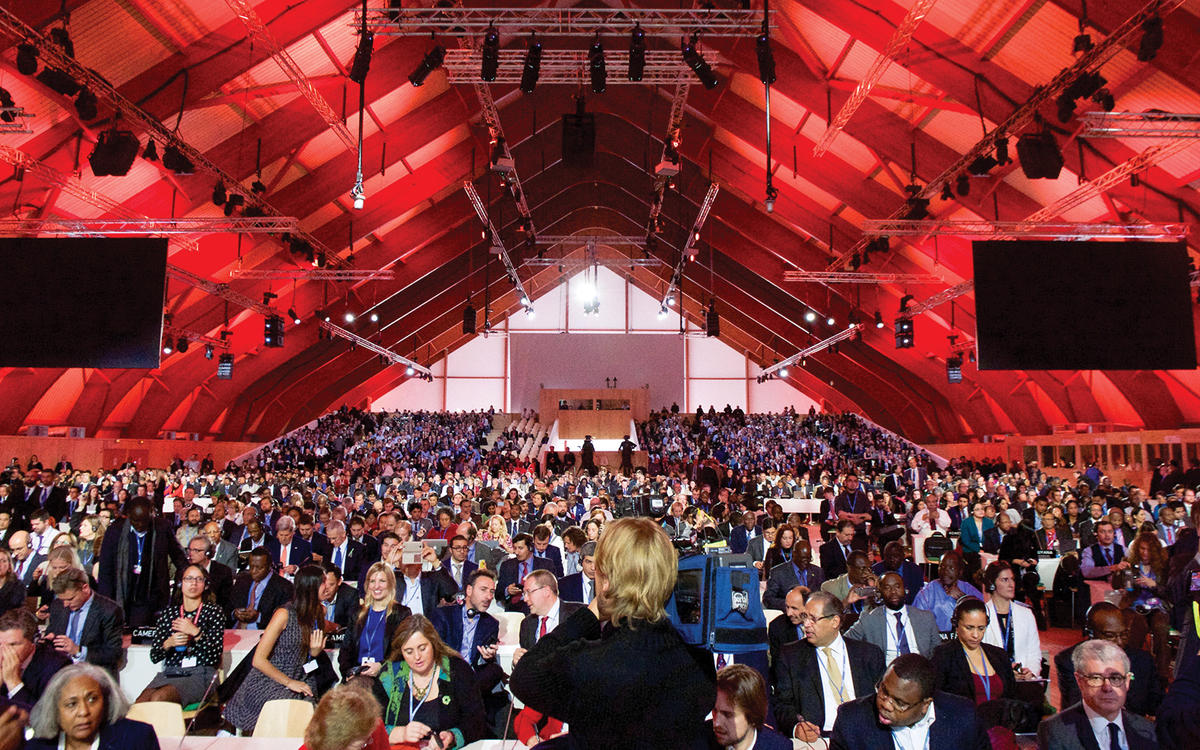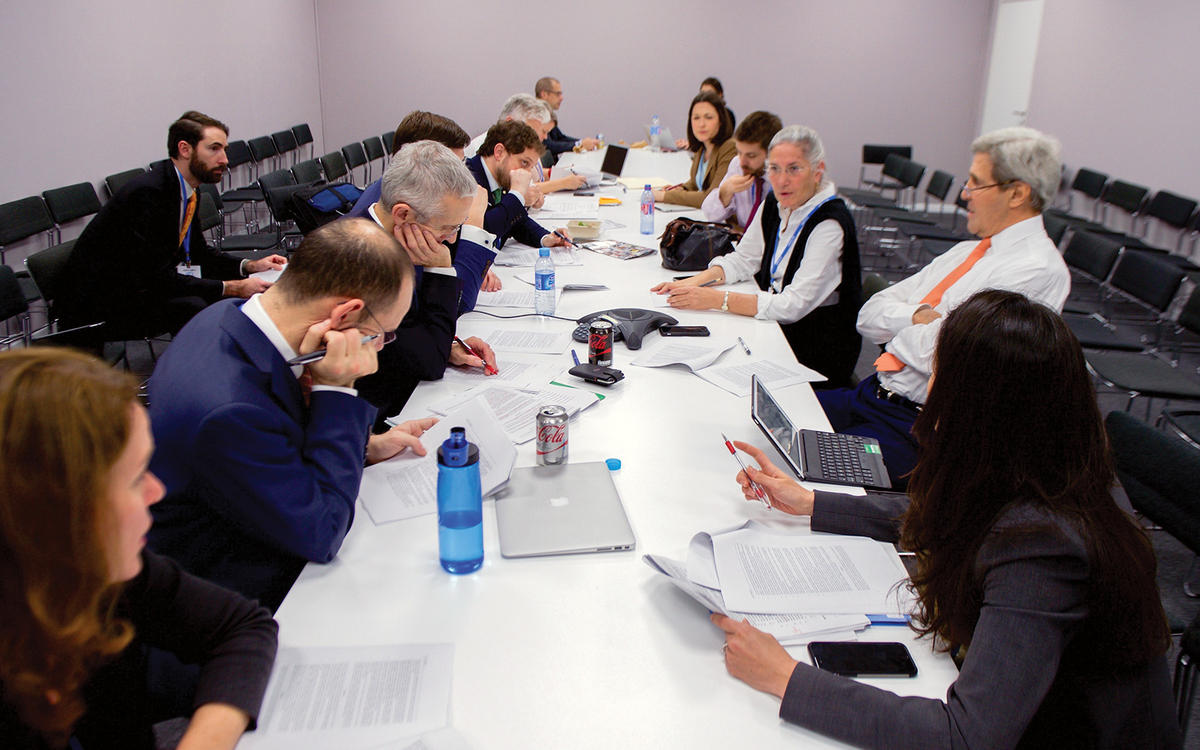An Existential Threat That Demands Greater FS Engagement
For more than 25 years, negotiators have worked around the world to meet the climate change crisis. The need to deepen this work will only increase, and greater FS engagement is essential.
BY TIM LATTIMER

Delegates to the 2015 United Nations Climate Change Conference assemble in the plenary hall in Paris.
Courtesy of Tim Lattimer
Though it was slow to unfold, the emerging crisis posed perhaps the gravest potential threat ever to human civilization. It menaced human health, economic development, social cohesion and the security of nations around the world. The only way out was to pull together a cooperative effort involving the entire global community. This meant undertaking the most complex, painstaking diplomatic process in history, with far-reaching implications. Are we talking about an impending attack by space aliens? No. Thermonuclear war? Nyet. Viral pandemic? Nope. Climate change? Yes, absolutely.
Climate change is one of the gravest dangers facing the world today, with profound implications for the future of all humanity. Notwithstanding the specious denials put forward by self-styled “experts” and the seeds of doubt sown by fossil fuel–funded think-tanks and pundits, the weight of scientific evidence shows that the burning of fossil fuels and other human activities are already driving significant changes to Earth’s climate. As a result, overall global average temperature has risen by about 0.85 degrees Celsius (about 1.5 degrees Fahrenheit) since the dawn of industrialization in the late 1800s.
While no increase is deemed safe, an increase of 1.5 to 2 degrees Celsius is widely viewed as the upper limit of what we might tolerate. Beyond that, we would likely face greater risks of catastrophic impacts. If left unchecked, this planet—still our only home—is on track to experience a global temperature rise of 4 degrees Celsius or more by 2100. Regardless of the Trump administration’s posture on the Paris Agreement, FSOs will have to contend—for better or worse—with the very real and enduring challenges and opportunities posed by climate change. These issues will long remain central to U.S. security and economic interests and will likewise remain of great interest to our partners around the world. We ignore them at our peril.
We are already seeing the effects of this change. Without a decisive shift to low-carbon energy sources, the impact will be even more devastating, threatening the very existence of some nations. Among other things, climate change brings:
• Increased frequency and severity of extreme weather events (e.g., prolonged droughts, killer heat waves and intense episodes of rain or snow);
• Changes in water patterns or flows, undermining agricultural production and food security;
• A rise in sea level, inundating coastal communities, destroying infrastructure, salinating sources of fresh water and submerging low-lying islands and prompting mass migrations;
• Ocean warming and acidification, which will destroy coral reefs, weaken marine food chains and threaten the food security of the billion or so people who depend on the sea for most of their protein;
• Spread of diseases (e.g., dengue fever, West Nile virus and Lyme disease) to previously untouched areas; and
• Mass extinctions of species, with one in six species at risk of disappearing in this century, thus tearing apart the interdependent web of life that sustains us all.
Pres. George H.W. Bush signed the United Nations Framework Convention on Climate Change at the June 1992 U.N. Conference on Environment and Development (the “Earth Summit”) in Rio de Janeiro.
As a consequence of potential climate-related social upheaval and economic disruption, successive secretaries of Defense, both Republicans and Democrats, have stressed that climate change poses serious security risks. Most recently, this past March, Defense Secretary James Mattis said that “climate change is a challenge that requires a broader, whole-of-government response.” Private-sector executives and local authorities are also increasingly focused on taking prudent steps to avoid or minimize their exposure to the risks posed by climate change. Why? Because it is clearly in their business and community interests to mitigate risks and seize the opportunities presented by the emerging clean energy economy.
In 1988, amid a growing body of scientific evidence and media hype about climate change, the United Nations created the Intergovernmental Panel on Climate Change to provide authoritative scientific and economic analyses, thereby laying the groundwork for eventual negotiation of an international climate agreement. Ever since, the U.S. State Department and American diplomacy have often led the way in meeting this challenge.
For more than 25 years, climate change negotiators across the globe have worked to bridge deep divides among virtually all of the world’s countries to reach consensus decisions with far-reaching implications for how economies are structured and how we will maintain a habitable planet. While Civil Service experts have done most of the heavy lifting on U.S. negotiating teams, career Foreign Service officers also play a vital role in the field, engaging with counterparts from around the world to cultivate relationships, build trust and explore possible compromises to overcome seemingly impossible differences.
A Global Response, Born in the USA
Climate change is much more than an environmental issue. It is fundamentally about how our economies are powered, i.e., the energy sources we use to drive economic expansion and job creation. In essence, international climate negotiations have been a “design and build” process, restructuring 21st-century economies so that we can move beyond fossil fuel-based development to low-carbon or zero-carbon development. No one country can solve the global challenge that is climate change, but the United States has an outsized role in finding a solution, both substantively and symbolically. Much of the world looks to the United States for leadership, not simply because of our political, military and economic might, but because of the historic responsibility we have as the largest historic emitter of greenhouse gases.
The State Department started laying the official U.S. government groundwork for climate negotiations in 1988. At that time, the Bureau of Oceans and International Scientific and Environmental Affairs (OES) moved Daniel Reifsnyder, a career civil servant, from its bilateral scientific cooperation office to lead a new office, the Office of Global Change (OES/EGC). Stephanie Kinney, then a mid-level FSO, joined the office in 1989. In August 1990, State pulled in Robert Reinstein, a veteran trade negotiator from the Office of the U.S. Trade Representative with a strong science and energy background, installing him as the OES deputy assistant secretary for environment. The OES Bureau’s first climate negotiating team—the trio of Reinstein, Reifsnyder and Kinney—enlisted the support of a career lawyer in State’s Office of the Legal Adviser, Sue Biniaz.
In June 1990, President George H.W. Bush surprised everyone—including the State Department—by announcing that the United States would host the first round of negotiations for a United Nations climate agreement in February 1991. With little time, no money and no venue, the small OES team scrambled to pull together an event in Chantilly, Virginia, that would host hundreds of diplomats and scientists from around the world.
From the beginning, developing country negotiators argued that climate change was a problem caused by industrialized nations, and that developing countries would be the primary victims. They maintained that it would be unfair for developing countries to forego the fossil-fuel driven lifestyles enjoyed in the United States, Europe, Japan and other developed nations. And, in what ultimately became history’s greatest shakedown, developing countries sought to condition their support for climate action on receiving, technology and capacity building from developed countries.
Following 18 months of tough negotiations, Pres. Bush signed the United Nations Framework Convention on Climate Change at the June 1992 U.N. Conference on Environment and Development (the “Earth Summit”) in Rio de Janeiro. The U.S. Senate gave its advice and consent promptly in October 1992, reflecting a bipartisan consensus that is virtually unheard of today. The UNFCCC set forth the ultimate objective of stabilizing greenhouse gas (GHG) concentrations in the atmosphere so as to avoid “dangerous [manmade] interference in the climate system.” Among many other provisions, it articulated the principle of “common but differentiated responsibilities and respective capabilities.” In essence, this justified putting the burden for emission reductions squarely on developed countries (the so-called “Annex 1” countries).

Secretary of State John Kerry confers with U.S. negotiators on the final text of the Paris Agreement.
Courtesy of Tim Lattimer
The Kyoto Protocol: DOA in the USA
By the mid-1990s, the realization that rising global emissions would blow past the convention’s initial goal—returning greenhouse gas emissions to their 1990s levels by the end of the decade—prompted calls from the European Union and others for stronger action. Developing countries continued to resist emission targets for themselves, arguing that it would be unfair to expect them to give up economic growth and poverty reduction because of a global problem that was not of their own making.
Faced with growing economic competition from rising powers like China and India, many Americans feared that higher (clean) energy costs would put the United States at a severe economic disadvantage to rivals having no emission limits. In July 1997, six months before the conclusion of the Kyoto negotiations, the U.S. Senate adopted the Byrd-Hagel Resolution by a vote of 95-0, expressing Senate opposition to any agreement that would harm the U.S. economy and that did not require emission limits for developing countries. Developing countries did not budge, despite the efforts of then-Vice President Al Gore in Kyoto.
Faced with the unhappy choice between blowing up a deal or going along with it in hopes of later overcoming domestic opposition, the United States went along with UNFCCC adoption of the Kyoto Protocol, which imposed specific GHG reduction targets only on “Annex 1” (developed) countries to be achieved by 2008-2012. During its final three years, the Clinton White House never sent the Kyoto Protocol forward for Senate advice and consent.
In April 2001, President George W. Bush announced that he would not seek the Kyoto Protocol’s ratification, effectively pulling the plug on a deal that had in any case been dead on arrival in the United States three years earlier. This move angered much of the world, prompting blowback in other arenas. Still, Russia’s ratification of the protocol in October 2004 put it into force in 2005; it was a clever move by Vladimir Putin that was less about combating climate change and more about isolating the United States. Despite real U.S. progress on climate and emission reductions in the ensuing years, much of the world saw the United States as “deadbeat dad”—the top historic carbon polluter ducking its obligations.
Quest for a Deal “Applicable to All”
When President Barack Obama took office in January 2009 UNFCCC negotiators faced the looming expiration of the Kyoto Protocol’s 2008-2012 commitment period. The chaotic December 2009 climate negotiations in Copenhagen, dubbed a failure by many, actually brought into bold relief a fundamental truth: putting the onus for action only on developed countries was no longer viable. Even if all developed countries met their ambitious targets, we would still be endangered by unchecked developing country GHG emissions, particularly driven by major emitters like China and India.
Cobbled together by Pres. Obama and other heads of state in a last-ditch effort to salvage the Conference of the Parties, the brief “Copenhagen Accord” reset the foundations for international climate diplomacy. It was the first-ever agreement calling on both developed and developing countries to articulate GHG emission targets for 2020, removing the first bricks from the “firewall” that previously shielded developing countries from setting quantified goals. In so doing, Copenhagen set the stage for the effort to develop a new deal by 2015 for the post-2020 period.
Given domestic U.S. politics, we had to have an agreement that, among other things, was “applicable to all” and that strengthened long-term ambition, ensured transparency with regular reporting and review, and was based on country-determined (“bottom-up”) targets and timetables rather than “top-down” ones imposed by others á la Kyoto. Led by then-Special Envoy for Climate Change Todd Stern, the State Department’s team composed primarily of career civil servants carefully crafted a new “pledge and review” approach that ultimately became the basis for the Paris Agreement. Stern relied heavily on two career civil servants—Office of the Legal Adviser’s lawyer Sue Biniaz and Office of Global Change Director Trigg Talley, whom Stern later tapped as his deputy special envoy.
The State Department climate team felt the impact when long-time climate champion and then-Senator John Kerry took the reins at State in 2013. Secretary of State Kerry elevated climate to the top of our diplomatic agenda, issuing his first department-wide policy memo focused on climate and including the issue as a regular fixture in his public statements. He and Pres. Obama pressed the U.S. agenda routinely in bilateral calls and meetings, as well as multilateral fora. Likewise, other top Obama administration officials lent their strong support on climate issues, including Energy Secretary Ernest Moniz, Agriculture Secretary Tom Vilsack, EPA Administrator Gina McCarthy and Science Advisor to the President Dr. John Holdren, among others.
Cobbled together by President Obama and other heads of state, the brief “Copenhagen Accord” reset the foundations for international climate diplomacy.
Several years of outreach and bargaining set the stage for the closing run-up to Paris. At the 2014 U.N. climate negotiations in Lima, UNFCCC parties chose State Department Deputy Assistant Secretary for Environment Daniel Reifsnyder to co-chair the committee charged with drafting the Paris Agreement. Thanks to his long history with the UNFCCC dating from its first days, Reifsnyder offered much more than his negotiating skills and his credibility as a fair arbiter. He also brought to bear his encyclopedic knowledge of climate issues and the extended tribe of UNFCCC players from around the world. With little fanfare, Reifsnyder teamed with his Algerian co-chair, Ahmed Djoghlaf, also a veteran climate negotiator, to shepherd the fractious parties through an intense succession of negotiations throughout 2015. In reconciling the incredibly diverse interests of nearly 200 parties, they developed a balanced package that ministers picked up to hammer out the final Paris Agreement.
Remarkably, Sec. Kerry participated actively throughout most of the final two-week Paris conference, huddling with the U.S. negotiating team, prodding other ministers and intervening from the floor at critical junctures during round-the-clock negotiations over the final text. Such strong and sustained political firepower from Pres. Obama and Sec. Kerry on down gave a huge lift to rank-and-file negotiators, particularly during the final stages of the UNFCCC’s relentless series of meetings heading into and at Paris.
The Role of the Foreign Service
Historically, State’s career civil servants have been the core of the U.S. government’s climate team supporting politically appointed lead negotiators. Their expertise encompasses multilateral negotiations as well as the many dimensions of climate such as clean energy, forestry and land use, adaptation and climate finance. Their creativity and skill in developing and implementing climate assistance programs led directly to fostering positive impact on the ground with developing countries, thereby building the goodwill and mutual understanding needed to resolve difficult negotiating issues and set the table for ministerial-level decisions.
At the same time, however, FSOs have played an important role throughout the course of the climate change effort. Doing the bread-and-butter work of career diplomats, they built relationships with a cross-section of host country colleagues, advocated forcefully for U.S. interests and positions, reported insightfully on the domestic needs and pressures affecting a country’s negotiating positions, and alerted Washington to changing circumstances that might open the way for closer cooperation (or requite greater effort).
This better enabled the special envoy for climate change and his team to engage in the meticulous task of building common cause with traditional and new allies, as well as to head off possible deal-breakers from players with ideological or economic motivations to prolong an international stalemate. It also helped Washington optimize the strategic use of foreign assistance, as the special envoy and his team designed and implemented highly effective bilateral and multilateral cooperation under the umbrella of the “Global Climate Change Initiative.”
Nonetheless, in an international negotiations process with such far-reaching implications, the relative absence of FSOs remains a problem. “I [was] the only FSO involved in what turned out to be one of the biggest issues and negotiations of the decade,” Stephanie Kinney said, recalling her work in the 1990s in her 2010 interview for the Association for Diplomatic Studies and Training’s Foreign Affairs Oral History Project.
Nearly a quarter-century later, I was one of only two FSOs who were part of the core delegation in Paris in 2015. We can, and we must, do better.
Perhaps few FSOs have taken part in U.S. climate diplomacy over the past quarter-century because they view climate as too “technical” or strictly the domain of “tree huggers.” Or maybe it’s because the State Department and Foreign Service culture remain stuck in a 20th-century mindset, which holds who the real power (and promotion) rests strictly with State’s regional bureaus.
Whatever the reasons, the climate change challenge will loom larger and larger going forward, affecting vital U.S. interests around the world. Recognizing the importance of having more FSOs play a more active, leading role in this fight, then-Secretary Kerry made “mitigating and adapting to climate change” a key strategic priority in the 2015 Quadrennial Diplomacy and Development Review. Among other things, the QDDR called for State and USAID to strengthen climate diplomacy and development; strengthen staff understanding of and engagement in climate issues; integrate climate change into all of our diplomacy and development efforts; designate critical countries for in-depth climate engagement; and expand climate and clean energy diplomacy beyond capitals.
We cannot wish the climate threat away. The need for FSOs to step up on climate remains ever more vital. OES leadership is cognizant of this need, and their efforts to open up greater opportunities for FSOs on these issues deserve strong support from the entire FS community.
We see the greatest progress when we have a deep bench involving people on all levels and of all skill sets, from chiefs of mission to political, economic and public diplomacy FSOs engaged on an issue. It is long past time that the department align its FSO recruitment, training and incentives to create a stronger cadre of FSOs who are eager and fully prepared to play more active roles in the fight to keep Earth habitable. Implementing the 2015 QDDR would be a good and important step in that direction.
An ESTH Officer’s Tricks of the Trade
Environment, Science, Technology & Health (ESTH) jobs offer great opportunities for our best FSOs to shine. You need not be a scientist or a physician to tackle these issues. You already have the requisite intellectual and communications skills to be an FSO. Here are some tips on how to be an effective ESTH officer, and maybe also have some fun along the way.
Connect your ESTH work to broader U.S. government and mission goals (e.g., security, prosperity and democracy). Help your front office see the links between ESTH issues and other priorities. You may also find synergies where you least expect them (e.g., your Mil Group or Narcotics Affairs Section might have assets that can help in combating illegal wildlife traffickers, not just the usual suspects). And pay attention to what top U.S. government leaders are saying and doing. You can bet that host country ministers and other counterparts do the same.
Get out and meet people in their own habitat. Find out their priorities and what they think. Calling on counterparts is about more than expanding your “contacts.” It is about building relationships and trust. Go to their place, and ask about their views and priorities. This helps you learn about what is really going on and enables you to provide better-informed reporting to Washington. Building trust quietly with counterparts puts deposits in the “emotional bank account” that you may later need to draw on when the chips are down.
Look for ways that U.S. interests might intersect with those of your counterparts. Demonstrating genuine attentiveness to their concerns, not just those of the United States, can open up possibilities for closer cooperation and win/win outcomes.
Be entrepreneurial. Yes, budgets are tight. But you can still exploit opportunities to harness and showcase American know-how. For example, pay attention to country clearance requests. You may discover an impending visit of a U.S. expert or a routine port call by American research vessels that could open up greater opportunities for official engagements or public outreach.
Make friends with your Public Affairs Section. ESTH issues often offer a bright spot in what might otherwise be difficult bilateral relations. Turn those pro forma scientific exchanges, document signings, ribbon-cuttings and the like into opportunities to drive ESTH-oriented public diplomacy messages.
If you’re in a separate ESTH unit, be sure to form a tight team with your Econ, FCS and FAS colleagues. You’ll likely find common interests—e.g., promoting the export of U.S. goods and services in clean technology or U.S. know-how in sustainable agriculture.
Rely on and support your Locally Employed staff. They can be your secret weapon in advancing U.S. interests and avoiding pitfalls. Not only do they have the institutional memory, but they may also know the technical or contextual issues better than you do. They may also be well-connected to their home country’s officials and thought leaders.
—Tim Lattimer
Read More...
- “From heatwaves to hurricanes, floods to famine: seven climate change hotspots”
- Interactive Graphic: “The Stakes in the Paris Climate Deal: What Might Other Countries Do?”
- “The effects of climate change will force millions to migrate. Here’s what this means for human security.”
- “Protecting the Ozone Layer”
- More on Climate Change and the Environment











